U.S. Review
String of Strong Data Unlikely to Dissuade July Rate Cut
- The string of strong data over the past week and a half—higher than expected inflation, retail sales and manufacturing production—likely will not dissuade the Fed from cutting rates 25 bps at its July meeting.
- The market-implied certainty of a rate cut this month would seem to belie the observed health of the U.S. economy. Retail sales surged in June, rising 0.4% for the third consecutive month.
- Yet with uncertainty swirling and inflation persistently low, we still expect a 25 bps cut this month.
String of Strong Data Unlikely to Dissuade July Rate Cut
The string of strong data over the past week and a half—higher than expected inflation, retail sales and manufacturing production—likely will not dissuade the Fed from cutting rates 25 bps at its July meeting. It should, however, dampen hopes for a 50 bps cut. The latest data indicate a resilient domestic economy, but the overwhelming market-implied certainty of a cut, as well as the lack of pushback from Fed officials against those expectations, suggest to us that a cut is too baked in at this point.
Such certainty of a rate cut this month would seem to belie the observed health of the U.S. economy. Retail sales surged in June, rising 0.4% for the third consecutive month. Over the same three months of the second quarter, control group retail sales rose an even stronger 0.5%, 0.6% and 0.7%, suggesting substantial upside to our current Q2 forecast of 3.4% annualized PCE growth. Such strength in consumer spending—which comprises roughly 70% of overall GDP—suggests that headline GDP is now tracking to come in north of 2%. The eye-raising drop in retail sales at the end of last year, which we maintained was largely a head fake stemming from the plunge in the stock market (see chart on first page), is now largely in the rearview mirror. Persistent labor market strength—June’s 224K-job gain was also above consensus—and fresh equity market highs have supported the ongoing rebound in consumer confidence and consumer spending. Industrial production was more or less flat in June, but manufacturing output rose a solid 0.4%. The U.S. factory sector appears to have just avoided slipping into contraction territory and has likely already bottomed. The trade détente may be providing some reprieve, but the ongoing uncertainty—underlying our forecast is the assumption that the United States and China will continue in the current holding pattern without reaching a deal for the foreseeable future—along with slowing global growth and a stronger dollar will put a ceiling on the manufacturing rebound. Forward-looking factory sector surveys also point to some rebound. The Empire Manufacturing survey for July came in at 4.3, above the consensus of 2.0, while the Philly Fed survey blew past the 5.0 consensus with its 21.8 reading. While these surveys contain more information on where the economy is heading, rather than where it has been, they are also highly volatile as managers attempt to digest a constant stream of trade rumors.
Residential construction has also likely bottomed, but the recovery has been anything but inspiring. A full percentage point drop in mortgage rates has failed to breathe much life into the housing market, which continues to grapple with affordability challenges. Housing starts fell 0.9% in June, largely due to a sharp decline in volatile multifamily starts. While single-family starts have now risen in three of the past four months, total starts year-to-date are running almost 4% below last year’s pace. The 6.1% drop in building permits, which lead starts, also dragged down the Leading Economic Index, which fell 0.3%, the largest drop since January 2016.
We remain in the peculiar situation wherein positive economic news can elicit a negative market reaction, as it diminishes the magnitude of expected Fed easing. Robust consumer spending data should indeed dampen expectations of a 50 bps cut in July and perhaps lower expectations of the extent of cumulative easing over the next year. Yet with uncertainty swirling and inflation persistently low, we still expect a 25 bps cut this month.
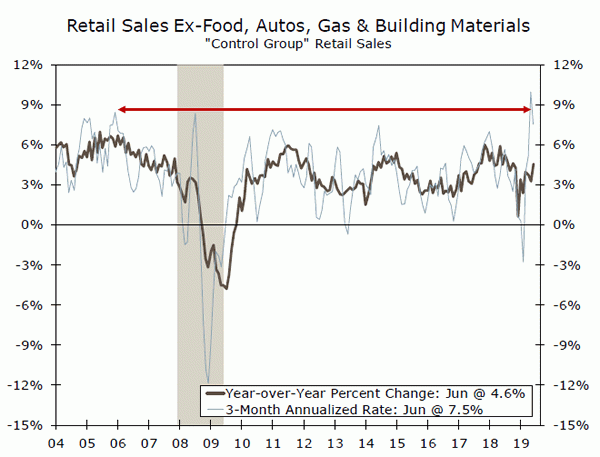
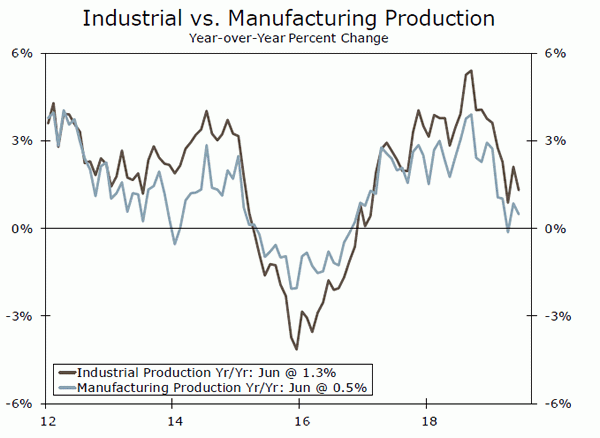
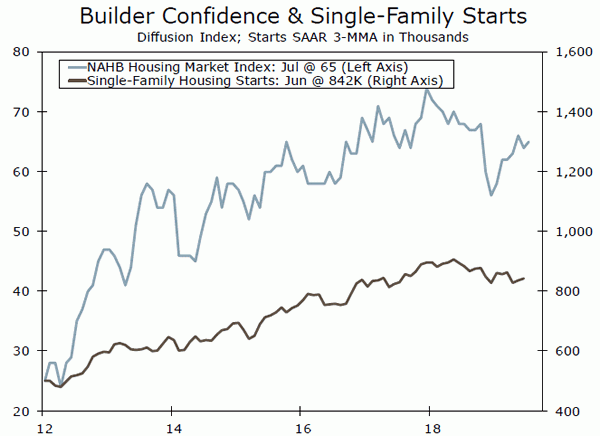
U.S. Outlook
Existing Home Sales • Tuesday
Driven by lower mortgage rates and ongoing labor market strength, existing home sales rebounded in May to a three-month high. Mortgage rates below 4% have created attractive buying conditions, yet the continuing mismatch between entry level demand and scarce entry level supply continues to play an outsized role in the lethargic pace of existing home sales during the first half of the year.
Consumers continue to feel reasonably optimistic about their employment and income prospects, which should provide support for home buying. Moreover, mortgage rates are expected to remain attractive, with the 30-year fixed mortgage rate likely to remain below 4% during the second half of the year. As more markets see more negotiating power switch from sellers to buyers, we look for existing home sales growth to improve in the coming months.
Previous: 5.34M Wells Fargo: 5.30M Consensus: 5.35M
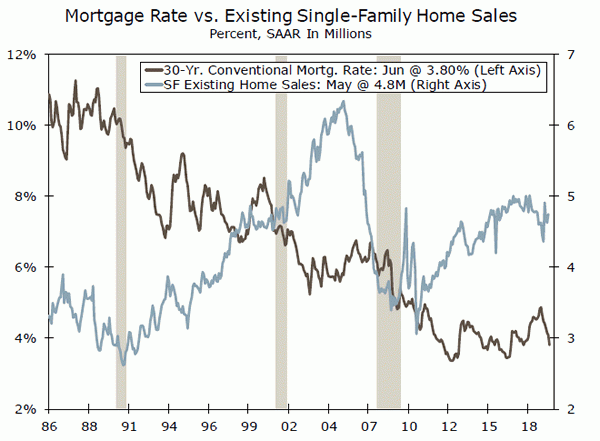
Durable Goods Orders • Thursday
Given the Fed’s mounting concerns, including slowing global growth and its impact on the manufacturing sector, Thursday’s release of advance durable goods orders will be highly anticipated by the markets and policy watchers.
Total durable goods orders fell 1.3% month-over-month in May, as civilian aircraft orders plunged for the second straight month amid Boeing’s struggles. 737 MAX model cancellations have led to roughly 30% declines in nondefense aircraft orders over the past two months. Excluding defense and aircraft, core capital goods orders held up better and suggest firms are not fully retrenching as they await clarity on trade policy. That said, the factory sector remains under pressure and incoming business sentiment measures continue to point to further weakness in Q3.
Previous: -1.3% Wells Fargo: 1.0% Consensus: 0.8% (Month-over-Month)
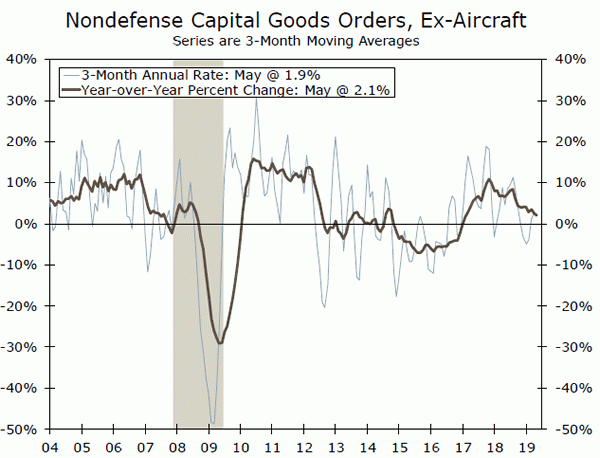
GDP • Friday
The first look at real GDP growth during the second quarter is released at week’s end and will also be closely scrutinized ahead of the July 30-31 FOMC meeting. First quarter GDP growth surprised to the upside, running at a 3.1% annualized rate and in line with last year’s strong pace. That said, outsized strength from inventories and trade masked marked softness in consumer spending.
For the second quarter, we look for these trends to reverse. Consumer spending is poised to bounce back. Ongoing labor market strength, combined with little detrimental impact associated from the U.S.-China trade war, have kept consumers’ attitudes and spending habits on a healthy path. Business investment growth, however, has slowed noticeably–weighed down by softer business spending, slowing global demand and concerns over trade tensions. We look for the longest running U.S. economic expansion to continue in the period ahead, albeit at a decelerating pace.
Previous: 3.1% Wells Fargo: 1.8% Consensus: 1.8% (Quarter-over-Quarter, Annualized)
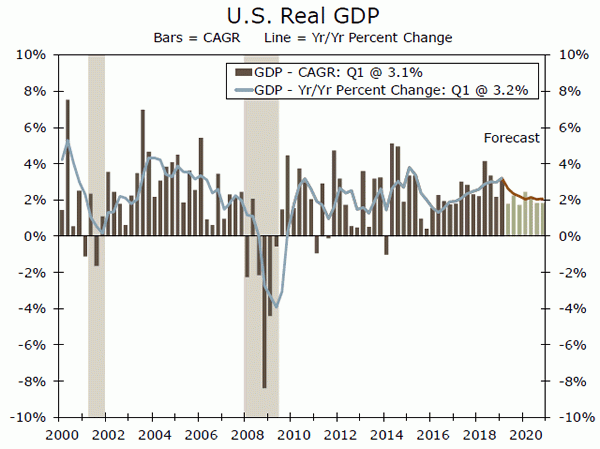
Global Review
China’s Economy Continues Its Gradual Slowdown
- Chinese GDP growth softened further in Q2 to 6.2% year-over-year, the slowest pace in several decades. Still, that is only modestly lower relative to growth in prior quarters, and indeed we expect the slowdown to continue at an orderly and managed pace.
- U.K. economic data released this week painted a picture of an economy that is holding up well despite mounting concerns around a no-deal Brexit. Wage growth strengthened and inflation remains contained, supporting solid gains in retail sales.
China’s Economy Continues Its Gradual Slowdown
The week in global economic data started off with the release of a slew of growth and activity data for China. Those data showed that China’s economy slowed further in Q2, as real GDP growth eased to 6.2% year-over-year, the weakest growth pace in decades. Monthly activity data for June were a bit more encouraging, as they showed stronger year-over-year growth in retail sales (+9.8%) and industrial output (+6.3%) during the final month of Q2. These mixed data reinforce the theme of an orderly and managed slowdown in Chinese GDP growth, supported by substantial policy easing from domestic monetary and fiscal authorities, most of which was delivered in 2018. We think the Chinese economy will continue to slow in the coming quarters, as we look for GDP growth of just 6.1% in full-year 2019 and 6.0% in 2020. Markets received a reminder of the downside risks to the outlook for growth in China, and the broader global economy, as U.S. President Trump again said he could impose more tariffs on China if he wants.
It was a busy week for the United Kingdom, with a mix of Brexit headlines and data points providing mixed signals for the U.K. economy and currency. On the Brexit front, reports early in the week suggested U.K.-E.U. discussions had taken an acrimonious turn, but more recent headlines signaled that E.U. chief negotiator Barnier may be willing to consider alternative arrangements for the contentious Irish border backstop. Meanwhile, U.K. data were generally quite strong, and consistent with an economy showing resilience in the face of persistent uncertainty. Indeed, retail sales rose 1% on a sequential basis in June, topping expectations for a small decline. Wage growth was firmer than expected in the three months through May, rising 3.4% year-over-year, which, coupled with generally contained core inflation (+1.8% year-overyear in June), is likely supporting the ongoing resilience in U.K. retail sales. The Bank of England has a relatively accommodative policy stance with its policy rate at 0.75%, and while current economic conditions might otherwise warrant a rate cut, Brexit uncertainty and the threat of a no-deal exit are probably too concerning for the central bank to raise rates for now.
Lastly, we had some news that the European Central Bank (ECB) was considering changes to its inflation goal, which is currently “below, but close to, 2%.” In that sense, the current 2% inflation target is more of a ceiling for inflation rather than a midpoint of a target range as some other central banks employ. President Draghi and other policymakers are supposedly exploring changing the inflation target to be more symmetrical around the 2% level. Any change would likely take quite some time to implement, but if the ECB were to change its inflation goal to a symmetric target around 2%, it would likely be consistent with lower interest rates for longer periods of time to encourage higher inflation. From a currency perspective, lower nominal interest rates and higher actual and expected inflation would likely mean a weaker euro, all else equal. However, we note that other central banks, including the Federal Reserve, are exploring similar changes to their inflation targets, and thus all else may not be equal after all.
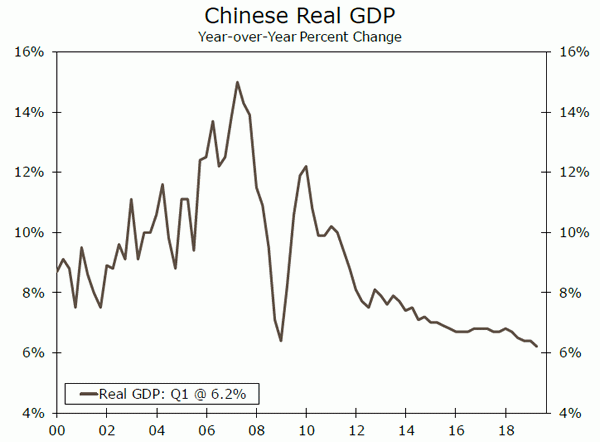
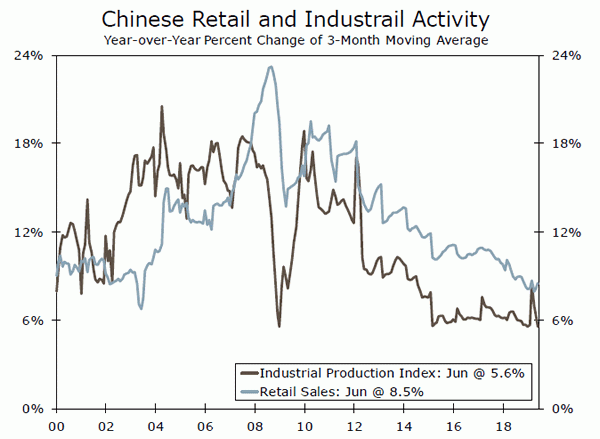
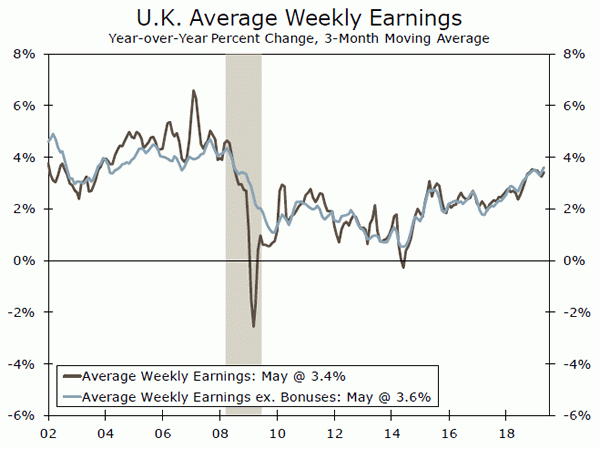
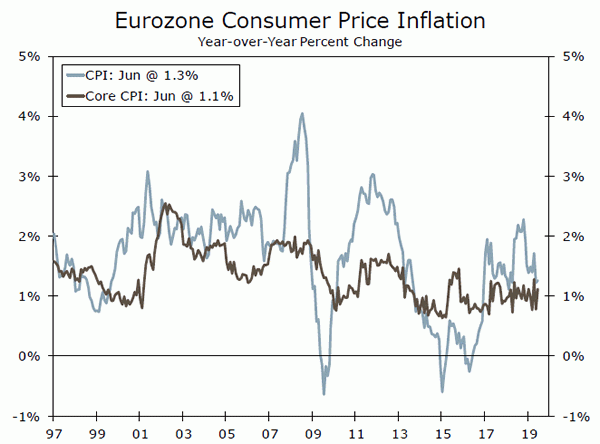
Global Outlook
South Korea GDP • Wednesday
Korea’s economy unexpectedly contracted in Q1, as real GDP fell 1.4% on a sequential annualized basis during the quarter. The decline was relatively broad-based, as output in the manufacturing, retail and construction sectors fell during the quarter. The economic picture has improved since then, as industrial output has recovered substantially and sentiment across the economy has moved higher in recent months.
Still, there are some downside risks to Korea’s Q2 GDP release next week, including overall weakness in global trade, to which Korea’s economy is particularly exposed. Korean exports have continued to decline in recent months, and fell 13.5% on a year-over-year basis in June. The surprise contraction in Singapore’s Q2 GDP last week also bodes ill for Korea’s trade-sensitive economy, and suggests the chances of a downside miss on Korean Q2 GDP are not small.
Previous: 1.7% Consensus: 1.9% (Year-over-Year)
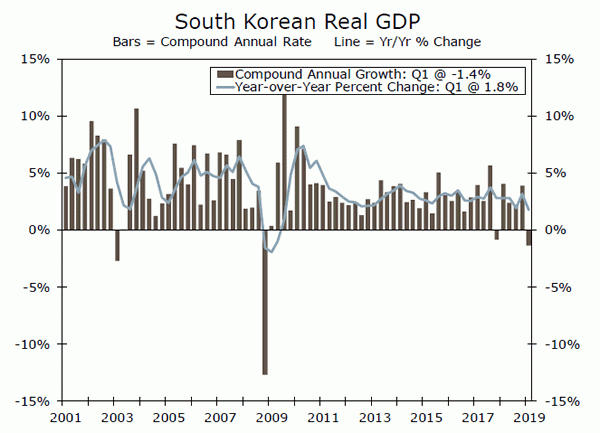
ECB Policy Announcement • Thursday
The European Central Bank (ECB) announces policy next week, and is widely expected to keep interest rates on hold. That is our expectation as well, although we look for the ECB to adjust its forward guidance to hint at a near-term rate cut (we expect it will cut its deposit and refinancing rates 10 bps to -0.50% and -0.10%, respectively, in September). At this time, we do not expect the central bank to restart its asset purchase program, although we acknowledge the risks have risen in recent weeks as the Eurozone economy continues to underwhelm.
Moreover, we see a moderate risk that the ECB will catch markets off guard next week and cut interest rates immediately, rather than waiting to see how the economy evolves between now and September. The ECB has made similarly surprising policy announcements in recent years, and a rate cut next week would carry strong messaging on the ECB’s commitment to its mandate.
Previous: -0.40% Wells Fargo: -0.40% Consensus: -0.40%
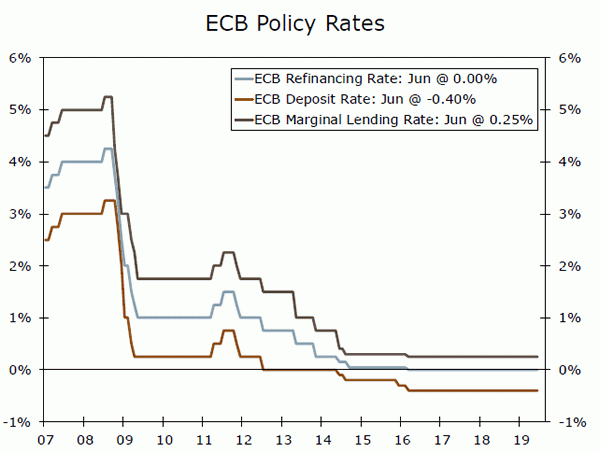
Mexico Economic Activity • Friday
Mexico’s economy has weakened on trend over the course of the year, as economic activity fell 1.4% year-over-year in April, the sharpest decline since 2013. The May figures will be released next week, and will be important in assessing whether the economy recovered as Q2 progressed. After a decline in Q1 GDP, the ongoing weakness in Mexican economic activity has some concerned that the country fell into technical recession (two consecutive declines in real GDP) in Q2.
The persistent softening in Mexico’s economy likely partly reflects relatively high real interest rates—Mexico’s central bank short-term policy interest rate is set at 8.25%, while inflation is currently just below 4%. Amid weak economic data, we expect the central bank to start to ease monetary policy in the relatively near term, and a weak print on economic activity could further support the case for rate cuts before long.
Previous: -1.4% (Year-over-Year)
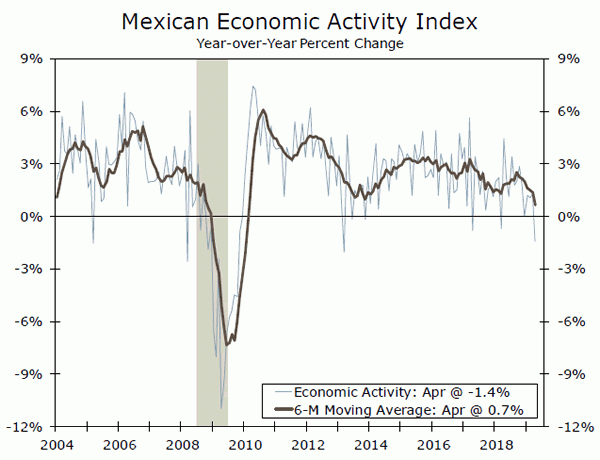
Point of View
Interest Rate Watch
Is a 50 Bps Cut Really in the Cards?
Approaching the FOMC’s meeting on July 31, there are virtually universal expectations that the committee will cut rates (top chart). Our view is that the FOMC will reduce the fed funds rate 25 bps. This is not because the economy is in dire straits, or anything close to it. Rather, the FOMC is concerned about the contentious trade environment weighing on global growth and leading to a significant slowdown in the United States, as well as inflation continuing to fall short of its 2% target (middle chart).
While in prior periods the FOMC may have been more willing to see how data and events unfold, the historically low level of the fed funds rate has led officials to adopt more of a “risk management” approach. As a result, many on the committee have signaled the need to add accommodation sooner rather than later.
But how much accommodation and how soon? The market’s estimates of a 50 bps cut surged late this week when FOMC Vice Chair Williams spoke about moving more quickly and adding more stimulus in a lowrate environment than one otherwise might. The market appears to have read too far into that, however, since the NY Fed made a rare effort to downplay his comments after, characterizing them as “academic.”
Nevertheless, markets are still pricing in about a 40% chance of a 50 bps cut (bottom chart). We believe the probability is notably lower than that, however. Yes, interest rates are lower than other periods when the Fed cut rates, which would be consistent with doing more sooner. But in past periods where the fed funds rate was slashed by so much, the economy was on the brink of recession or just emerging from one.
The 1995-96 period of “insurance” cuts has been viewed as a template for today. At that time, the FOMC cut in three 25 bps increments. The economy looked on shakier ground, with the ISM index in contraction territory and job growth having slowed from more than 300K jobs per month to only a little over 100K. We suspect that a 50 bps cut would suggest the economy is in a more fragile position than it is, and risk broader confidence in this expansion (not to mention the Fed’s independence).
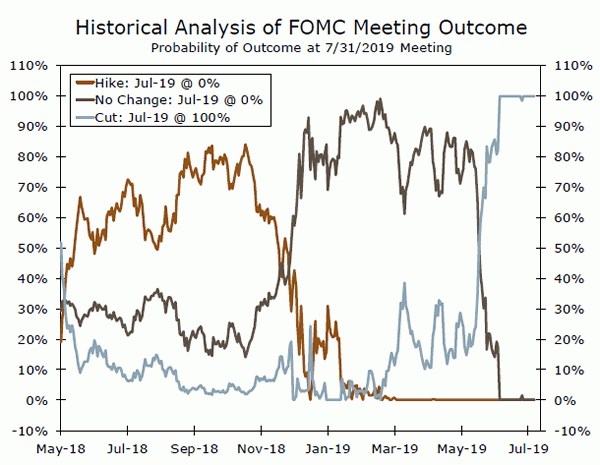
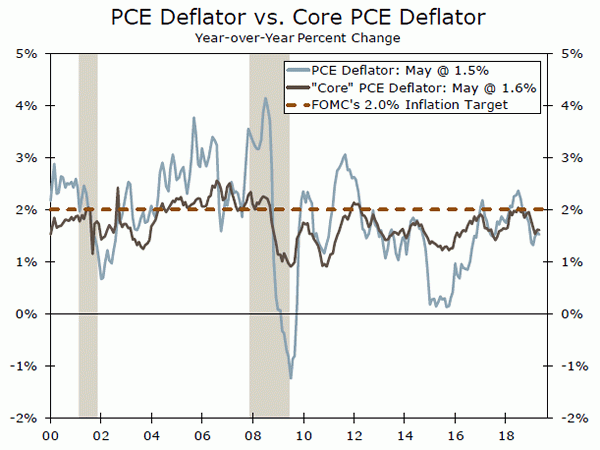
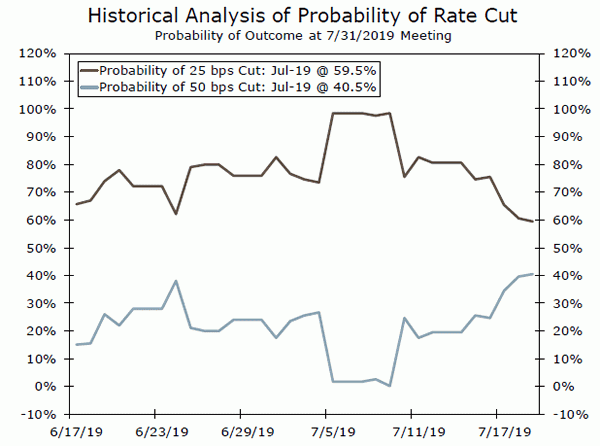
Credit Market Insights
India’s Struggles with FPIs
Despite an improved credit rating, India has experienced a significant outflow of foreign investment from its sovereign bonds. Currently, foreign portfolio investors (FPI) hold 73.1% of the maximum allowed foreign ownership, while in 2017 and 2018 FPI holdings hovered near 100% of the cap. Withdrawals from sovereign Indian debt come in part from foreign investors transitioning into Indian equities. Although the Indian government prefers that most of its sovereign debt is domestically held, the Reserve Bank of India (RBI) recently upped its foreign investment limits in efforts to help raise around $10 billion USD this year through sovereign bond offerings. The funds raised are expected to alleviate some budgetary pressures stemming from new welfare initiatives.
In a recent budget speech, Finance Minister Nirmala Sitharaman announced plans to offer dollar-denominated sovereign bonds in an effort to make Indian government debt more attractive to foreign investors and diversify its borrowing. However, this borrowing plan could create foreign exchange risks. Since October 2018, the rupee has become increasingly weaker against the dollar after India’s first quarter GDP growth fell to its lowest level since Q1- 2014 and newly reelected Prime Minister Narendra Modi has struggled to restore confidence. Thus, India faces the challenge of attracting sufficient foreign investment to fund its growth while also not exposing its internal finances to undue foreign exchange risk.
Topic of the Week
Is the End Near?
The leading economic index (LEI) is a key barometer for the direction of the economy and it is undeniably losing momentum. The LEI has been more or less flat since September and declined 0.3% in June, which marks the first decline this year and the largest monthly drop since the start of 2016. The six-month average change stands at 0.03%, which is also tied for the weakest pace since 2016. So what is the predictive power of this index, and should we take its recent stall as an omen for an impending downturn?
It is true that a downturn has not come without a declining LEI, but a declining LEI has not always resulted in a downturn. Take the 2015-2016 period for example. Oil prices cratered in 2014, dragging down business fixed investment and business confidence, and the LEI moderated as a result. Glancing at the top chart, there is no denying, however, that the index looks reminiscent of prior cycle peaks. But, as seen in the bottom chart, the LEI has traditionally registered consecutive monthly declines anywhere from five to eight months prior to a downturn. Moreover, the six-month average change has not yet turned negative. This average smooths out sharp movements in particular components of the LEI, such as the plunge in building permits, which comprised almost all of the 0.3% decline in the headline this month. To put the 6.1% drop in June permits in perspective, it was the largest monthly decline since March 2016, and enough to drag down the LEI 0.18 percentage points. ISM new orders and unemployment claims were also weak in June. More notably, as the yield curve spread turned negative in June (as measured on a monthly basis), it made a negative contribution to the LEI for the first time since 2007. But still, strength in the average workweek, stock prices and consumer expectations components were definitely encouraging signs that the economy is not falling off a cliff. We would need to see a sustained decline and broad-based weakness in the LEI before we would chalk its weakness up to a coming recession. Instead, we view the recent moderation as a signal that growth will remain lackluster in the second half of the year.
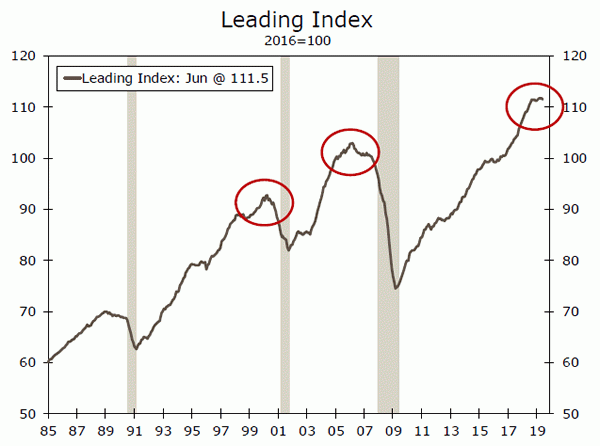
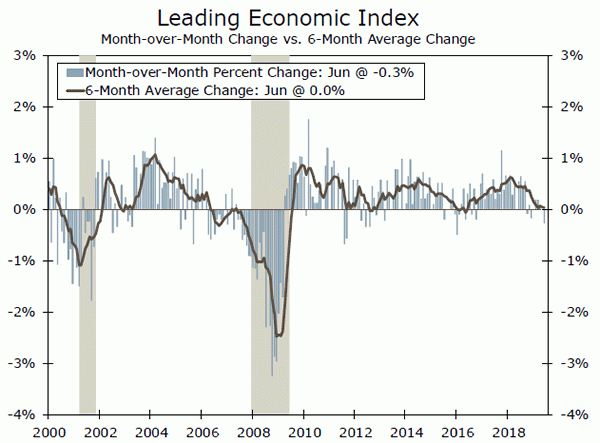

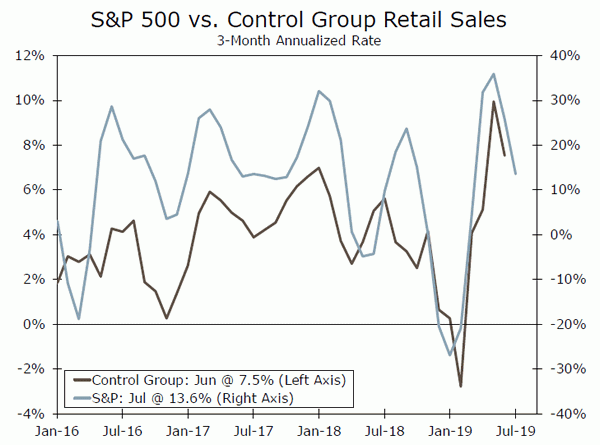
 Signal2forex.com - Best Forex robots and signals
Signal2forex.com - Best Forex robots and signals




